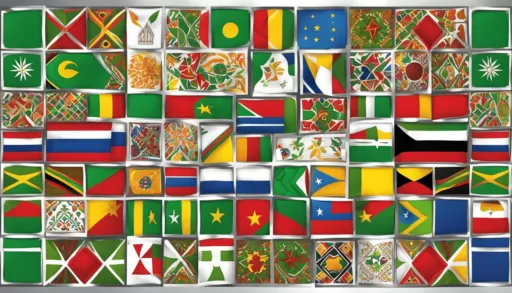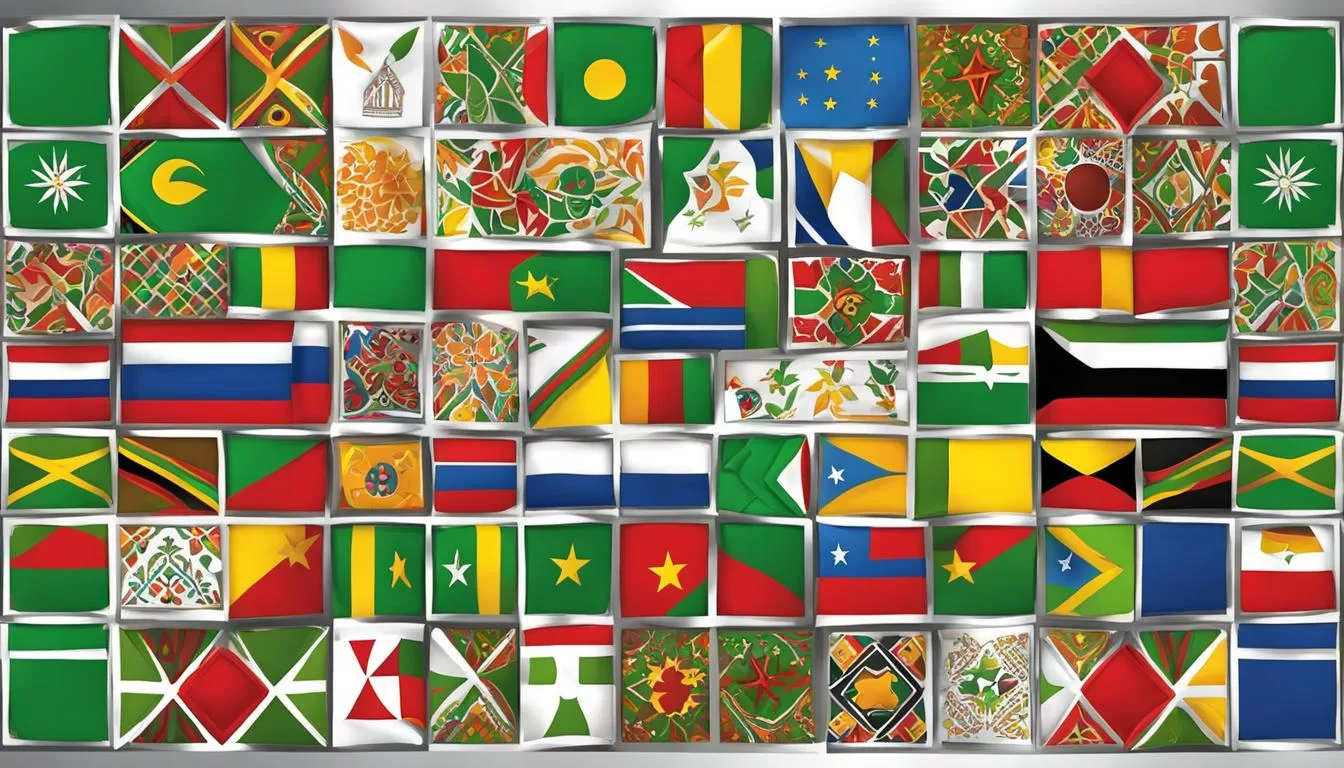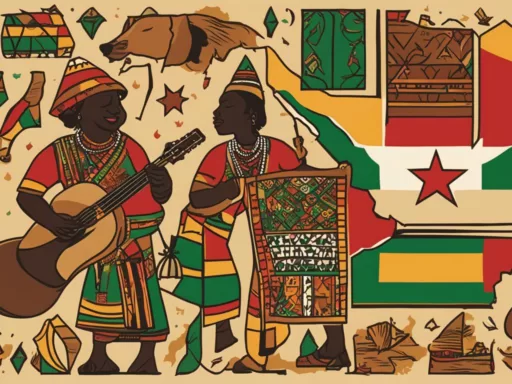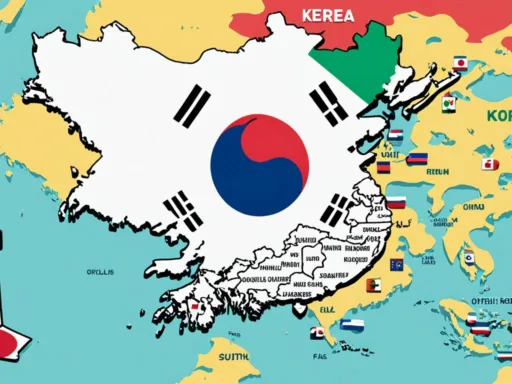In the heart of the Indian Ocean lies the archipelago of Comoros, a nation celebrated for its remarkable linguistic diversity. The languages spoken in Comoros are a compelling testament to the islands’ dynamic history and the cultural intersections that have defined its society. Recognized under its 2001 constitution, the Comoros official languages—Comorian, French, and Arabic—serve not only as a bridge connecting Comoros to its colonial past but also as pillars maintaining the vibrant and diverse modern Comorian culture. This constitution not only preserves the cultural significance of each language but also promotes unity within the mosaic of communities that make up the nation.
Comoros’ multilingual fabric is woven with various dialects and languages, reflecting centuries of trade, migration, and colonial influence. As one explores Comoros, the presence of other tongues that colour the local dialects, such as Malagasy and Swahili, despite their limited usage, becomes apparent. It’s this intricate interplay of languages that artistically captures the essence of Comorian identity—an identity rooted in a rich, interconnected history that continues to flourish in its speech and traditions.
Key Takeaways
- Linguistic Variety: Comoros’ tapestry is richly threaded with multiple languages, embodying its multifaceted cultural narrative.
- Comorian Dominance: While multiple languages are spoken, Comorian, which is the most widely understood and used, serves as the linguistic backbone of the country.
- Colonial Legacies: French remains a potent official language due to Comoros’ historical ties with French colonialism.
- Spiritual Connections: Arabic underscores the religious heritage of the majority Sunni Muslim population.
- Minority Languages: Languages like Malagasy and Swahili, although less prevalent, contribute to the islands’ linguistic wealth.
- Cultural Preservation: Recognition of official languages ensures cultural preservation and respect for the archipelago’s history.
The Linguistic Landscape of Comoros
Immersed in the turquoise waters of the Indian Ocean, the Comoros archipelago is renowned for its splendid Comoros linguistic diversity. With a historical saga that touches upon ancient maritime trade routes, French colonization, and Arabic influence, the Comorian language stands as a testament to the unique cultural blend that defines the nation. Each of the islands contributes its distinct dialect to the collective language, which, though varied, allows for unified communication, reflecting the close-knit nature of Comorian society.
Introduction to Comoros’ Multilingualism
The archipelago’s multilingual character is rooted in the native languages that have evolved and sustained themselves over centuries. Exhibiting significant versatility, the language ecosystem in Comoros is influenced by the region’s role as a nexus in historic maritime commerce. Therefore, the indigenous languages of Comoros mirror a rich intercultural tapestry that has been spun through countless interactions amongst traders, colonizers, and indigenous peoples.
Diverse Influences on the Language Tapestry
From the shores of Grande Comore to the lush hills of Moheli, languages sparkle with varied nuances honed by time. The Comorian language, or Shikomoro, vividly encapsulates the soulful melodies of East African Bantu languages, unified yet expressed through a variety of local dialects. Each island smiles in its own linguistic style, with Shingazija, Shimwali, and Shinzwani dialects weaving a kaleidoscope of audible heritage across the Comoros. However, it’s in the undulating rhythms of Swahili that one can trace the echoes of the archipelago’s trading legacy with the East African Coast and the Arabian Peninsula.
Moving through the annals of time, the French colonization of Comoros has left an enduring imprint on the language landscape, intermingling with the native tongues and elevating French as a vital language of administration and commerce. Similarly, the Arabic influence has seeped deep into the fabric of Comorian society, far beyond its religious implications, illustrating the potency of language as both a connector and a bearer of history.
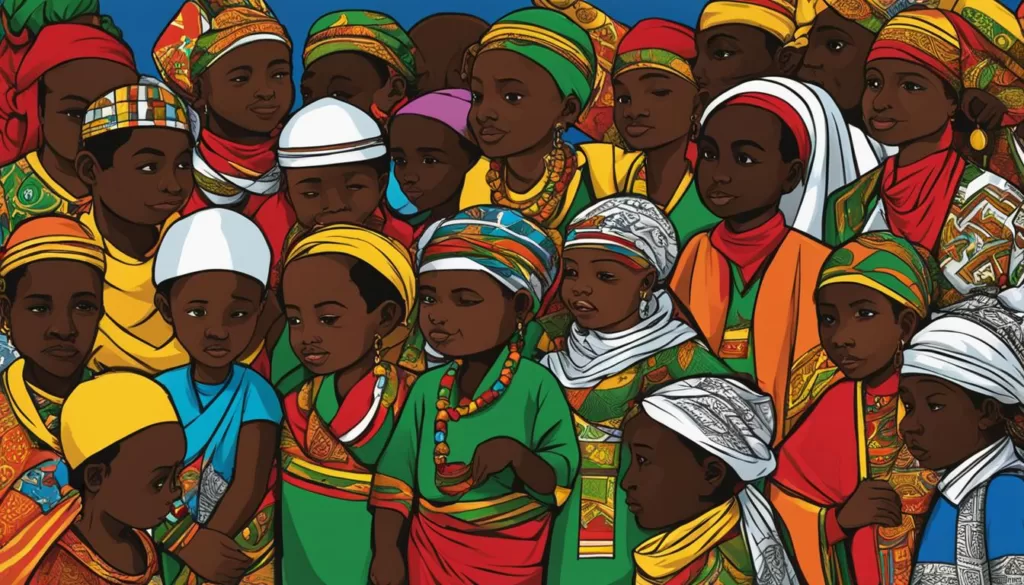
Capped off by the sporadically heard Malagasy and the historical richness of Swahili in Comoros, the archipelago’s language diversity is nothing short of a polyphonic symphony. It is in understanding these linguistic depths—where echoes of ancestors converse with the tide—that one gains a profound appreciation for the Comoros, an island chain with a narrative voiced in a multitude of tongues.
Languages Spoken Comoros: A Closer Look
Diving into the linguistic essence of Comoros, we find a mosaic of Comorian language dialects painting a vivid picture of cultural interactions. Among these, the Shingazija dialect stands out, emanating predominantly from Grande Comore. However, to fully appreciate the communicative dynamics in Comoros, we must also recognize the Shimwali dialect of Moheli and the Shinzwani of Anjouan. Join us as we unravel the layers of this fascinating linguistic map.

In the examination of languages spoken Comoros, we see that despite some variances, these dialects exhibit a significant degree of mutual intelligibility, effectively facilitating intra-island dialogue and understanding. This shared comprehension underscores the islands’ steadfast connectivity and the unifying power of language amidst diversity.
The sociolinguistic fabric of the Comoros is intricate and delicate. It is the thread from which the islands’ stories are woven, reflecting a history rich in exchanges and a future aspiring toward linguistic unity. The question remains: Which dialect will ascend as the definitive national language? Such debates flavor the ongoing conversation about linguistic identity within Comoros, revealing how language shapes communal bonds and individuality.
| Language/Dialect | Island | Speakers | Features |
|---|---|---|---|
| Shingazija | Grande Comore (Ngazija) | Approx. 312,000 | Predominant, widely understood |
| Shimwali | Moheli (Mwali) | Approx. 29,000 | Distinctive, localized usage |
| Shinzwani | Anjouan (Nzwani) | Approx. 275,000 | Widespread, resembles Shingazija |
The quest for a cohesive national language is more than a pursuit of a communicative medium—it is an endeavor to symbolize national identity and pride. This multi-dialectal landscape gives us a glimpse into the depth of the communicative dynamics in Comoros, highlighting how the power of speech goes beyond mere words and becomes an emblem of unity amidst the archipelago’s diversity.
Unpacking Comoros’ Official Languages
In the warm embrace of the Indian Ocean, the archipelago of Comoros boasts a compelling linguistic diversity that anchors its rich cultural fabric. This linguistic landscape is peopled with the harmonious presence of three official languages, each carrying the weight of history and the warmth of daily life.
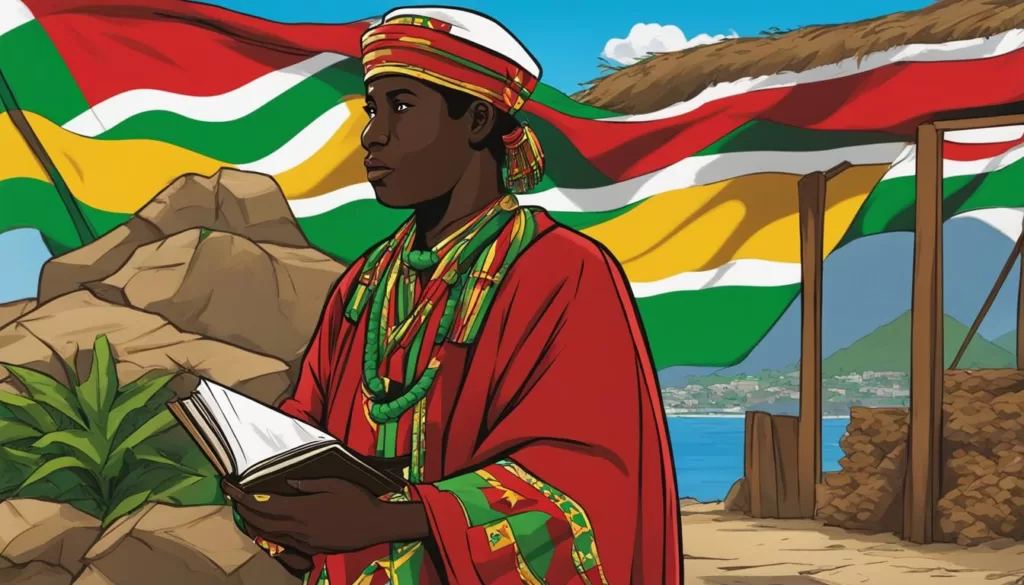
Comorian: The Heart of Local Communication
The Shikomori language, with its intrinsic connection to the indigenous Comorian dialects and East African Bantu languages, forms the crux of interpersonal interactions within the archipelago. This language, entrenched in the islands’ day-to-day existence, showcases the resilience of tradition as Comorians navigate their modern life. Shikomori is more than just a medium of communication; it’s the lifeline of Comorian heritage, echoing from the bustling markets to the tranquil villages across the islands.
French in Comoros: Language of Administration and Education
Walking through the streets of Comoros, one cannot miss the linguistic footprints of its colonial history. French in Comoros serves not merely as a relic of the past but as a vital organ of the nation’s administrative and educational framework. As a gateway to opportunities within and beyond the islands, French reinforces Comoros’ identity as a proud Francophone nation, connecting it to a global community while fostering a distinct educational ethos.
Arabic in Comoros: Religious Significance and Education
Arabic in Comoros weaves a different kind of spell, one that resonates with the spiritual chords of the archipelago’s majority Sunni Muslim faith. It goes beyond its official status, embedding itself in the educational realm, where the Arabic educational influence sheds light on scholarly pursuits and cultural enlightenment. As you listen to the Islamic call to prayer, Arabic stands as a sentinel of devotion, imparting religious tenets to the faithful and bridging centuries of Islamic scholarship.
Indigenous and Minority Tongues: Comoros Native Languages
The rich tapestry of the Comoros native languages is interlaced with threads from distant lands and bygone eras, presenting a cultural mosaic that mirrors the archipelago’s indigenous roots and historical passages. Languages such as Shibushi and Swahili continue to speak of the Comoros’ vibrant history and the resilience of minority language demographics in the face of change.
The significance of Swahili in Comoros cannot be understated. As an instrumental force in shaping commerce and communication across the Indian Ocean, the presence of Swahili is indelible in the nation’s cultural memory. Despite having a smaller number of speakers compared to the official languages, Swahili cements its place by highlighting the Swahili historical significance in Comoros, notably through ancient writings that utilize Arabic script. This feature underscores a diverse narrative where language and tradition intertwine.
Shibushi, a dialect of Malagasy, showcases the depth and diversity of Comoros’ linguistic heritage. Its unique existence on the islands also tells a story of migration, settlement, and survival, revealing the dynamic character of Comorian society. Within this context, the minority language demographics play a vital role in the fabric of national identity, offering a window into the past and enriching the contemporary cultural landscape.
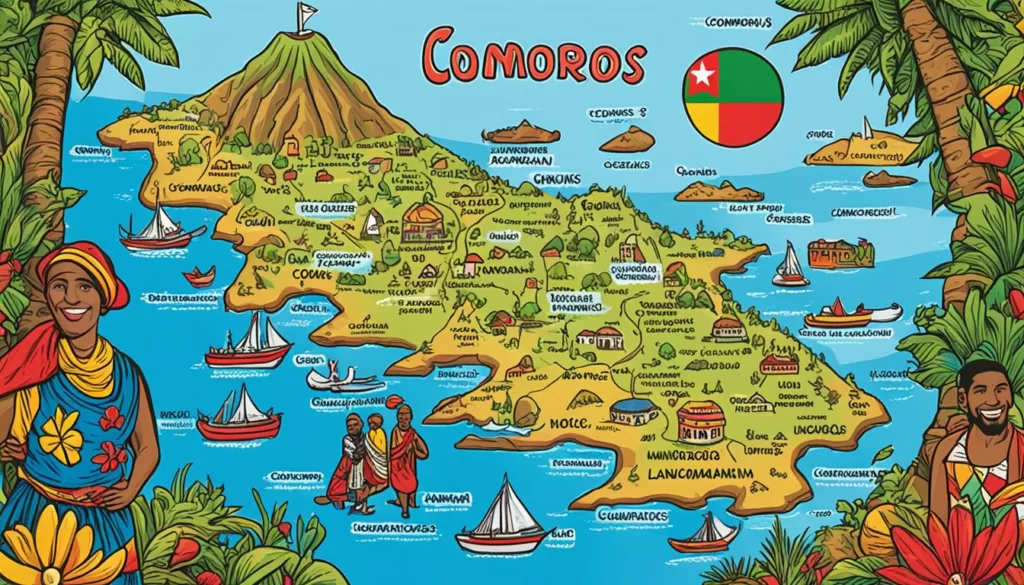
Amidst the sea winds and the soothing sounds of the ocean, the voices of Comoros rise in a symphony of dialects and accents. The remarkable endurance of these minority languages amidst the waves of change pronounces the deep-rooted connection between language, culture, and communal identity in Comoros.
Conclusion
Delving into the linguistic diversity in Comoros unveils a vibrant tapestry interwoven with the threads of history, culture, and communication. The official languages—Comorian, French, and Arabic—not only serve the functional needs of the Comorian society but also enrich the language and culture in Comoros. Each tongue paints a part of the larger picture of Comoros, capturing the essence of the islands’ storied past and its dynamic present. As a nation standing at the crossroads of various civilizations, Comoros offers an exceptional opportunity to explore the profound connections between language and identity.
For those intrigued by the notion of learning Comorian language, diving into the dialects of Shikomori presents a unique lens through which to view and understand the local life and customs of the islands. Learning Shikomori or any of Comoros’ languages is not just about acquiring a means of communication; it’s about immersing oneself in the rhythms of Comorian life, understanding its pulse, and embracing its ancient soul. The language landscape of Comoros, thus, provides a compelling entry-point into the heart of its society.
In conclusion, embracing the full spectrum of Comoros’ linguistic heritage offers more than just linguistic knowledge—it offers a gateway to appreciating the intricate mosaic of the islands’ culture and societal norms. The rich plurality of voices in Comoros tells a story of resilience, evolution, and unity that continues to resonate across the Indian Ocean and beyond. So, whether one is charting the academic depths of Shikomori or simply eager to communicate heartily with the welcoming Comorian locals, each phrase and word conveys the intricacies of a legacy that has thrived amidst the tides of change.
FAQ
What languages are officially recognized in Comoros?
Comoros officially recognizes three languages: Comorian, French, and Arabic. These languages reflect the nation’s historical and cultural ties.
How prevalent is the use of the Comorian language among the population?
The Comorian language, locally referred to as Shikomori, is spoken by approximately 97% of the population. It is the most prevalent language in everyday communication among Comorians.
Are there different dialects within the Comorian language?
Yes, there are several dialects of the Comorian language, which vary from island to island. Notable ones include Shingazija, Shimwali, and Shinzwani, each corresponding to Grande Comore, Moheli, and Anjouan islands respectively.
Does French play a significant role in Comoros today?
French remains a key language in Comoros, primarily used within the realms of administration and education. Its pervasive influence as a consequence of French colonization ensures that it is a lingua franca in the country, particularly in formal settings.
What is the significance of Arabic in Comoros?
Arabic in Comoros carries a special significance because it is associated with the Sunni Muslim faith which is the predominant religion in the country. Even though its everyday use is more limited, Arabic is still employed in religious education and is also seen as a language of prestige and scholarly learning.
Are there any indigenous or minority languages in Comoros?
Yes, besides the main official languages, there are indigenous and minority languages such as Shibushi, a dialect of Malagasy, and Swahili, which has historical significance as a lingua franca in trade. These languages contribute substantially to the richness of the Comorian linguistic environment.
How does linguistic diversity in Comoros affect culture?
The linguistic diversity in Comoros is a critical aspect of the nation’s cultural identity. The different languages and dialects spoken in Comoros reflect the islands’ layered history and have a profound impact on local traditions, practices, and social interactions.
Is there a standardized orthography for the Comorian language?
As of yet, there is no fully standardized orthography for the Comorian language. However, efforts have been made to standardize its written form, reflecting the country’s endeavor to solidify its linguistic identity post-independence.
Can visitors to Comoros get by with just knowing French or Arabic?
French would be more useful to visitors since it’s widely used in government, education, and business, whereas Arabic might be helpful in religious or educational settings. Understanding basic French phrases could significantly improve communication for travelers to the islands.
Is learning the Comorian language beneficial for understanding local culture?
Absolutely. Learning Comorian not only facilitates communication with the majority of the local population but also offers deeper insights into the social and cultural nuances of the island nation.
